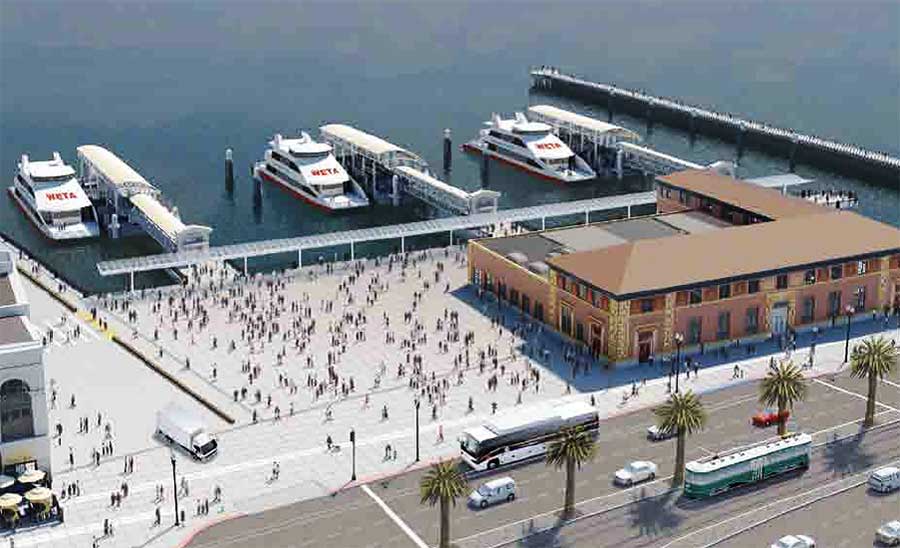The nearly $80 million Downtown San Francisco Ferry Terminal Expansion Project is moving forward, as the contractor recently finished removing obstructions and debris to clear the way for a crane mounted barge to enter the lagoon for pile driving work.
The project is being overseen by the San Francisco Bay Area Water Emergency Transportation Authority (WETA) and the Port of San Francisco. Work, which began in May of this year, will allow for expanded regional ferry service, alleviate current overcrowding, and increase WETA’s emergency response capabilities in the event of a regional transportation disruption or disaster.
Expected to be operational in 2019, the project was designed by the San Francisco-based ROMA Design Group, while Power Engineering Construction Co of Alameda, CA is the contractor. Simpson Gumpertz & Heger (SGH) of Los Angeles is the engineer.
The Downtown San Francisco Ferry Terminal Expansion Project includes construction of two new ferry gates and vessel berthing facilities that will support new ferry services from San Francisco to Richmond and Treasure Island, as well as other potential locations currently under study.
Officials say the project will also improve landside conditions at the San Francisco Ferry Terminal by providing new amenities such as weather-protected canopies, a new plaza area south of the Ferry Building, the extension of pedestrian promenade areas and other public access improvements.
With initial site demolition and dredging work complete, crews are currently working on driving piles to support the new deck structure and floating docks that will be built as part of the project, which is presently about 10 percent complete.
In the past week obstructions and debris were removed and the contractor has successfully mobilized its derrick barge into the lagoon to begin driving piles. The steel pipe piles range in size from 24" to 30" to 36" in diameter and from 140 ft to 155 ft in length. The piles are driven approximately 120 ft into the bay mud. A 100-ton barge is being used to install the piles.
Mike Gougherty, WETA project manager, says the site is composed of a variety of soil types deposited at different depths through man-made and natural means. "WETA has undertaken extensive geotechnical investigations and engineering work to ensure that the project is appropriately designed for the existing soil conditions and can withstand potential impacts during a major seismic event, including settlement and soil liquefaction," he says.
Gougherty says the most fascinating challenge on the job is constructing in such a densely-used and highly visible area of Downtown San Francisco.
"The project site is surrounded by foot, bicycle, transit and vehicle traffic," he says. "In addition to ensuring that other users and uses near the project site are not impacted, the project must be constructed while keeping the current facility operational to support the Alameda and Oakland ferry services."
He says due to the intensity of activity near the project site, very little space is available for construction staging. As a result, the contractor has arranged for most larger materials to be delivered to the site by barge.
"Additionally, WETA and its designers have worked closely with the contractor to sequence the project in a manner that allows for continuous operation of the ferry terminal throughout construction," says Gougherty. "Because certain activities can only occur during certain times of the year, and sometimes there are up to 10 barges on-site, carefully planning and scheduling is especially important on this project in order to avoid delays and potential conflicts with existing ferry operations."
The Metropolitan Transportation Commission (MTC), the transportation planning, financing and coordinating agency for the nine-county San Francisco Bay Area, allocated $22 million in Regional Measure (RM) 2 funds to the terminal project, with the remainder of the funding for the $79 million terminal project coming from state Proposition 1B and Federal Transit Administration funds.
“This project is one facet of WETA’s $465 million investment in assets and infrastructure — including new terminals, maintenance and operations facilities, and vessels— to expand ferry service, prepare the system for future routes, and increase our emergency response capabilities,” said Nina Rannells, WETA executive director in a news release.


Post a comment to this article
Report Abusive Comment